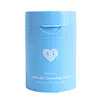What's inside
What's inside
 Key Ingredients
Key Ingredients

 Benefits
Benefits

 Concerns
Concerns

 Ingredients Side-by-side
Ingredients Side-by-side

Water
Skin ConditioningButylene Glycol
HumectantIsohexadecane
EmollientPolyacrylamide
Avena Sativa Kernel Extract
AbrasiveOryza Sativa Bran Extract
Skin ConditioningInositol
HumectantGlycyrrhiza Glabra Root Extract
BleachingGlycerin
HumectantPolysorbate 20
EmulsifyingC13-14 Isoparaffin
EmollientC9-11 Pareth-6
EmulsifyingAluminum Starch Octenylsuccinate
AbsorbentAscorbyl Glucoside
AntioxidantParfum
MaskingDMDM Hydantoin
PreservativeSodium Hyaluronate
HumectantCollagen
MoisturisingSodium Lactate
BufferingWater, Butylene Glycol, Isohexadecane, Polyacrylamide, Avena Sativa Kernel Extract, Oryza Sativa Bran Extract, Inositol, Glycyrrhiza Glabra Root Extract, Glycerin, Polysorbate 20, C13-14 Isoparaffin, C9-11 Pareth-6, Aluminum Starch Octenylsuccinate, Ascorbyl Glucoside, Parfum, DMDM Hydantoin, Sodium Hyaluronate, Collagen, Sodium Lactate
Water
Skin ConditioningPropanediol
SolventDicaprylyl Carbonate
EmollientNiacinamide
SmoothingCaprylic/Capric Triglyceride
MaskingCetearyl Olivate
Sorbitan Olivate
EmulsifyingPentylene Glycol
Skin ConditioningHydroxyethyl Acrylate/Sodium Acryloyldimethyl Taurate Copolymer
Emulsion StabilisingGlycerin
Humectant1,2-Hexanediol
Skin ConditioningHouttuynia Cordata Extract
Skin ConditioningCentella Asiatica Leaf Water
Skin ConditioningBisabolol
MaskingGlyceryl Caprylate
EmollientPolysorbate 80
EmulsifyingButylene Glycol
HumectantButyrospermum Parkii Butter
Skin ConditioningHydrogenated Lecithin
EmulsifyingHyaluronic Acid
HumectantSodium Hyaluronate
HumectantHydrolyzed Hyaluronic Acid
HumectantEthylhexylglycerin
Skin ConditioningGuaiazulene
AntimicrobialCeramide NP
Skin ConditioningBeta-Glucan
Skin ConditioningTocopherol
AntioxidantPhenoxyethanol
PreservativeAvena Sativa Kernel Extract
AbrasiveHoney Extract
HumectantWater, Propanediol, Dicaprylyl Carbonate, Niacinamide, Caprylic/Capric Triglyceride, Cetearyl Olivate, Sorbitan Olivate, Pentylene Glycol, Hydroxyethyl Acrylate/Sodium Acryloyldimethyl Taurate Copolymer, Glycerin, 1,2-Hexanediol, Houttuynia Cordata Extract, Centella Asiatica Leaf Water, Bisabolol, Glyceryl Caprylate, Polysorbate 80, Butylene Glycol, Butyrospermum Parkii Butter, Hydrogenated Lecithin, Hyaluronic Acid, Sodium Hyaluronate, Hydrolyzed Hyaluronic Acid, Ethylhexylglycerin, Guaiazulene, Ceramide NP, Beta-Glucan, Tocopherol, Phenoxyethanol, Avena Sativa Kernel Extract, Honey Extract
Ingredients Explained
These ingredients are found in both products.
Ingredients higher up in an ingredient list are typically present in a larger amount.
Avena Sativa Kernel Extract is is derived from colloidal oatmeal. Besides being a healthy breakfast, oats have many benefits in skincare too.
This ingredient helps sooth, hydrate, and protect the skin. The starches in colloidal oatmeal are able to bind water, keeping the skin hydrated.
The cellulose and fiber in colloidal oatmeal help reduce inflammation. This can also help the skin feel softer.
Colloidal Oatmeal is also an antioxidant. Antioxidants protect our skin from free-radical damage.
Oatmeal also contains beneficial compounds:
This ingredient is created by mixing grounded oatmeal and a liquid base.
Learn more about Avena Sativa Kernel ExtractButylene Glycol (or BG) is used within cosmetic products for a few different reasons:
Overall, Butylene Glycol is a safe and well-rounded ingredient that works well with other ingredients.
Though this ingredient works well with most skin types, some people with sensitive skin may experience a reaction such as allergic rashes, closed comedones, or itchiness.
Learn more about Butylene GlycolGlycerin is already naturally found in your skin. It helps moisturize and protect your skin.
A study from 2016 found glycerin to be more effective as a humectant than AHAs and hyaluronic acid.
As a humectant, it helps the skin stay hydrated by pulling moisture to your skin. The low molecular weight of glycerin allows it to pull moisture into the deeper layers of your skin.
Hydrated skin improves your skin barrier; Your skin barrier helps protect against irritants and bacteria.
Glycerin has also been found to have antimicrobial and antiviral properties. Due to these properties, glycerin is often used in wound and burn treatments.
In cosmetics, glycerin is usually derived from plants such as soybean or palm. However, it can also be sourced from animals, such as tallow or animal fat.
This ingredient is organic, colorless, odorless, and non-toxic.
Glycerin is the name for this ingredient in American English. British English uses Glycerol/Glycerine.
Learn more about GlycerinSodium Hyaluronate is hyaluronic acid's salt form. It is commonly derived from the sodium salt of hyaluronic acid.
Like hyaluronic acid, it is great at holding water and acts as a humectant. This makes it a great skin hydrating ingredient.
Sodium Hyaluronate is naturally occurring in our bodies and is mostly found in eye fluid and joints.
These are some other common types of Hyaluronic Acid:
Learn more about Sodium HyaluronateWater. It's the most common cosmetic ingredient of all. You'll usually see it at the top of ingredient lists, meaning that it makes up the largest part of the product.
So why is it so popular? Water most often acts as a solvent - this means that it helps dissolve other ingredients into the formulation.
You'll also recognize water as that liquid we all need to stay alive. If you see this, drink a glass of water. Stay hydrated!
Learn more about Water